On Saturday, Feb. 14, the Rosetta spacecraft swooped low over the surface of comet 67P/C-G in the first dedicated close pass of its mission, coming within a scant 6 km (3.7 miles) at 12:41 UTC. The image above is a mosaic of four individual NavCam images acquired just shortly afterwards, when Rosetta was about 8.9 km from the comet.
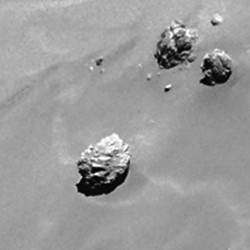
The view above looks across much of the Imhotep region along the flat bottom of comet 67P’s larger lobe. (See a map of 67P’s named regions here.) At the top is the flat “plain” where the Cheops boulder cluster can be seen – the largest of which is 45 meters (148 feet) across.
Read more: Rosetta Gets a Peek at Comet 67P’s Underside
The zero phase angle of sunlight during the pass made for fairly even illumination across the comet’s surface.
The image scale on the full mosaic is 0.76 m/pixel and the entire view encompasses a 1.35 × 1.37 km-wide area.
Other NavCam images acquired before and after the pass have been assembled into mosaics – check those out below:
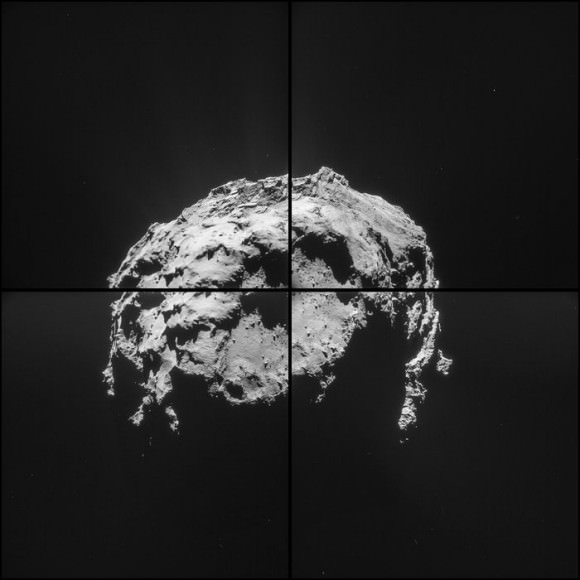
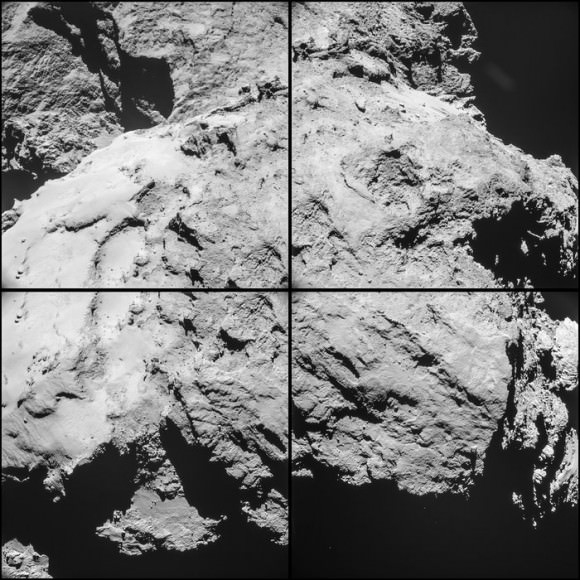
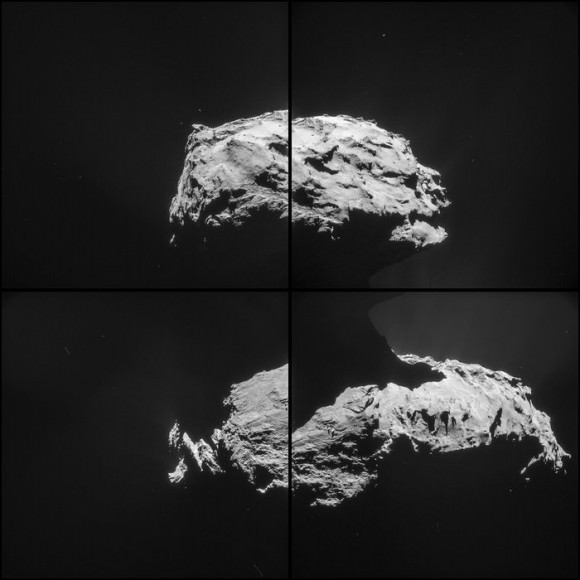
In addition to NavCam images of 67P, Rosetta also acquired high-resolution OSIRIS images of the comet and gathered scientific data about its coma environment during the flyby. These data will be downlinked and processed over the next week or so.
Flybys will be regular parts of Rosetta’s operations over the course of 2015, but due to the comet’s increasing activity none will bring the spacecraft as close as this particular pass.
Rosetta is now moving out to a distance of about 250 km (155 miles) from 67P. Watch a video below of how the Feb. 14 flyby was planned and executed:
Source: ESA’s Rosetta blog
______________________
(Also, on Feb. 9, Rosetta captured a full-frame NavCam image of 67P from 105 km. I’ve edited that image for additional contrast and added a blue tint. Enjoy!)
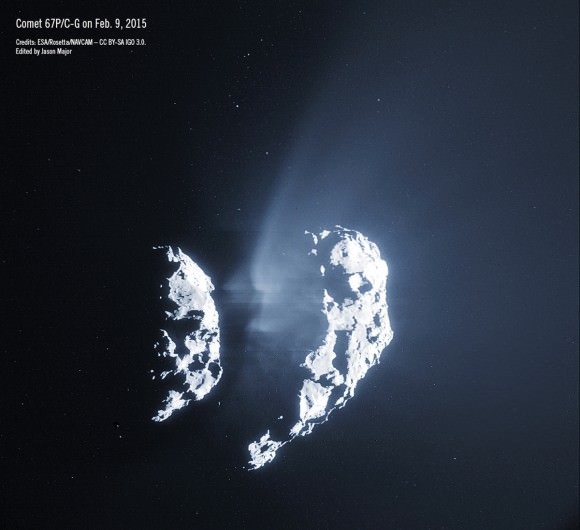

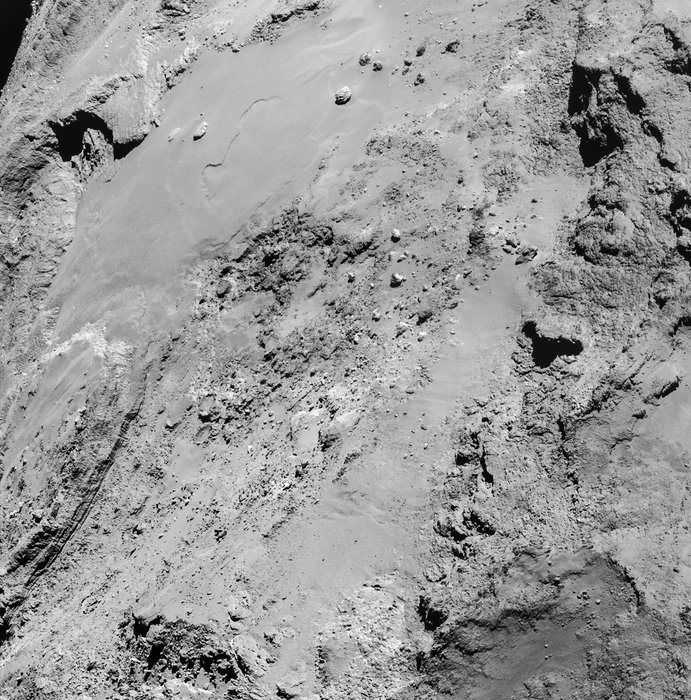
When is the date that they expect the surface to turn to mud?
(Above 0° Celsius)
I see a face!
Really, I don’t. But maybe UT will blog about it anyway since it is a smiley face and UT wants to stay optimistic, to say the least. Like the Orion going to Mars and such.
Well that was just an uncalled-for jab. Having a bad day?
Is it a “jab”?
If UT claims that Orion will go to Mars, within its 3 weeks life support, then why not let also P/67 go to Mars?Wouldn’t that be a great improvement, that EVERYTHING GOES TO MARS!
Do you have a pingpong ball? IT WILL GO TO MARS!” Just post it to anyone of the bloggers here, and it will become THE TRUTH! In 10, no, five, years, everyone who wants to, will live in a great city on Mars. Anyone who uses information or logic, will be degraded as ” a jabber”. That solves all the challenges.
This article isn’t even about Mars.
Jason… FALA is an old troll with a new name who has haunted UT with obstructionist rants for years. Best to ignore him.
You are ranting.
Pill…..
Those who look at the first picture and still believe the ugly fake story about the dirty snowballs, are blind . THis is a piece of a mountain , a rocky terrain no a snowball
The EU was right from the day 1
Nah, it doesn’t have the necessary density to be made of solid rock.
What we’re looking at is a dusty surface crust, covering a more ice-rich interior. The physical processes that give rise to this structure have been verified in the lab; I can’t link to it because it takes forever for the moderators to approve posts here but if you google “Comet’s Structure Is Like Deep-Fried Ice Cream” you can see for yourself.
There is no need to invoke bizarre ideas like a comet made of rock that somehow has the density of pine wood, and has a strong electric charge but somehow produces little to no magnetic field and did not affect Philae at all on the way down.
I believe you’re looking for this: http://www.jpl.nasa.gov/news/news.php?feature=4480
Some of those boulders are resting really lightly on the surface. They haven’t sunk into the soil at all. Of course this is to be expected, since the comet has such low gravity, but it is still striking.
I see a indian chief and a owel.
My goodness! How about concentrating on the substance. Anyone notice the strata in the “lower half” of the mosaic of the comet? It makes me wonder what the cause is. Perhaps ancient volcanism? Some sedimentary processes of various ages? Are they sedimentary breccias formed after many impacts? Did those layers form when this was a bigger body in the past? Are they deposits formed as a result of the outgassing processes over billions of years? Maybe some of the close up pictures could resolve enough detail to at least pin them down as igneous, sedimentary, or metamorphic. I’m waiting for this comet to split into two segments. What a great opportunity this would be to study the processes.
That last image is just too way double extre groovy cool! A comet comes to life… Good job J-mans!
Isn’t it kind of weird that the most significant jets emanate from the parts of 67P that are out of touch from the sunlight, like shaded areas?
The shaded areas aren’t always shaded. The comet rotates on all axes.